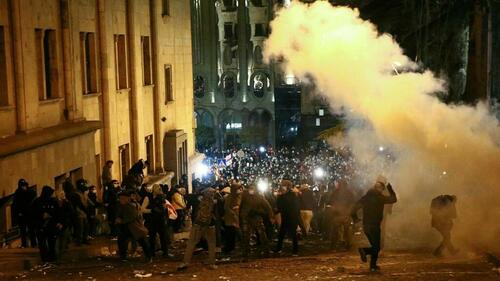26 years have passed Since the signing of the Dagomys or Sochi agreements that ensured the entry of Russian peacekeepers into South Ossetia in 1992,
On June 24, 1992, residents of Russia and Georgia Boris Yeltsin and Eduard Shevardnadze, with the participation of the leaders of South and North Ossetia, Torez Kulumbegov and Akhsarbek Galazov, signed an agreement on the principles for the settlement of the Georgian-Ossetian conflict.
On July 14, in accordance with these agreements, the Mixed Forces for Peacekeeping and Law Enforcement were introduced into South Ossetia and adjacent areas of Georgia, which entered the conflict zone. These events marked the beginning of a 12-year peaceful respite for the residents of the Republic, which lasted until 2004, when a new phase of the Georgian aggression began.
The signing of the Dagomys agreements was preceded by several years of bloody war, the reason for which was the coming to power in Georgia of neo-fascist forces headed by Zviad Gamsakhurdia, who proclaimed the slogan "Georgia for Georgians".
Deciding to withdraw from the USSR, the Georgian authorities denied South Ossetia and Abkhazia the right to withdraw from Georgia, despite the fact that such a possibility was guaranteed by the legislation of the Soviet Union.
Since November 1989, the information war against Ossetians has developed into armed aggression and mass ethnic cleansing. As a result, more than 1 thousand inhabitants of South Ossetia were killed and missing, about 2,5 thousand people were injured, about 55 thousand refugees from South Ossetia arrived in North Ossetia. About 120,000 Ossetians, who used to live in different regions of Georgia, were also forced to flee from ethnic cleansing. The number of Ossetians killed by the Georgian neo-Nazis on the territory of Georgia itself is still unknown.
In addition, 117 Ossetian villages were burned, a significant part of the Republic's capital lay in ruins.
The coup d'état in Georgia in early 1992 and the civil war that started there have somewhat weakened the activity of the Georgian troops against South Ossetia. However, since the spring of 1992, Eduard Shevardnadze, who came to power after the overthrow of Zviad Gamsakhurdia, against the background of appeals for reconciliation, launched large-scale military operations against South Ossetia.
The city of Tskhinval was completely blocked and subjected to round-the-clock shelling from artillery and missile installations. At the same time, the execution of refugees on the Zarskaya road is carried out.
However, despite the losses and colossal superiority in the forces of the Georgian formations, the South Ossetian self-defense forces managed to defend the capital of the Republic and the main settlements.
Atrocities and war crimes by Georgia aroused indignation of the patriotic public of the Russian Federation, demanding that the destruction of South Ossetia be stopped.
Particularly noteworthy is the role of North Ossetia, where, albeit with procrastination, was nevertheless realized the threat to South Ossetia. One of the factors that prompted the then leadership of Russia led by Yeltsin to intervene in the current situation was mass rallies in Vladikavkaz demanding an immediate cessation of bloodshed in South Ossetia, as well as seizures of warehouses with weapons and equipment. The situation reached the point where the Supreme Council of North Ossetia appealed to the federal center, stressing that in case of further delay, the Republic reserved the right to withdraw from the federation and would help the southern brothers. All these factors influenced the further course of events. In the first half of June 1992, the Commission of the Supreme Council of the Russian Federatio, after studying the situation, suggested the Russian Security Council take measures to cease fire and warn Georgia of the possible consequences.
Thus, the Dagomys, or Sochi agreements, signed on June 24, 1992, were the result of the struggle of the Ossetian people and support from North Ossetia, as well as patriotic forces in Russia. Four-sided talks between Russia, Georgia, North and South Ossetia led to the signing of the agreement on the principles of the settlement of the Georgian-Ossetian conflict. In accordance with this agreement, tripartite peacekeeping forces were introduced into South Ossetia, which included one battalion from each side-a total of 1,500 men. However, despite the agreement signed on June 24, Georgian troops continued their military operations against South Ossetia right up until the very entry of the peacekeeping forces on July 14, 1992.
In particular, on July 12, continued intensive bombardment of Tskhinval from all types of weapons, including tanks, infantry fighting vehicles, artillery and mortars. As a result, only from 6 pm on 12 July 7 people were killed and 42 people were injured. Many houses in Tskhinval are destroyed. The fire was fought not only from the southern and eastern outskirts of the town, but also from the north, from the village of Tamarasheni. The attacks on the Ossetian villages of the Tskhinval and Znaur districts, in particular Jer, Styrk, and others also continued.
In this regard, the Supreme Council of the Republic of South Osswith a request to fully promote the bringing of mixed peacekeeping forces into South Ossetia and not take into account the attempts of the Georgian side to delay in every way the fulfillment of treaty obligations achieved in Dagomys.
The Dagomys agreements, in addition to the introduction of the Joint Peacekeeping Forces in South Ossetia, provided for the creation of a special body for the settlement of the conflict - the Joint Control Commission (JCC), which included representatives of four sides - Georgia, South Ossetia, Russia and North Ossetia with the OSCE participation.
From 1992 to 2008, despite provocations and constant attempts by the Georgian authorities to neutralize Russia's role in the negotiation format, the Rpublic continued to participate in the settlement process in the internationally recognized format of the JCC, and the effectiveness of the tripartite peacekeeping operation was at one time recognized by the Georgian side.
The new escalation of tension in the conflict zone began in 2004 and was directly related to the coming to power in Georgia of Mikhail Saakashvili, who announced his plans to solve problems with South Ossetia and Abkhazia by force.
His actions, actively supported by Western countries led by the US, were aimed at Georgia's withdrawal from the Dagomys agreements and the withdrawal of Russian peacekeeping forces from South Ossetia. The policy of the new Georgian Fuhrer led to destabilization of the situation and an attempt to arrange another genocide of the Ossetian people in August 2008. The blow was inflicted on Russian peacekeepers who for many years acted as guarantors of the implementation of the Dagomys agreements.
However, Saakashvili's military adventure came up against Russia's strong response, which successfully carried out an operation to force the aggressor to peace and recognized the independence of South Ossetia.
But this happened 16 years after Dagomys, and then in summer 1992, quadripartite agreements led to peace in South Ossetia, albeit temporary.








